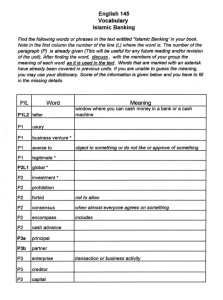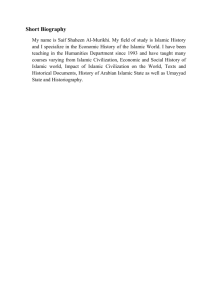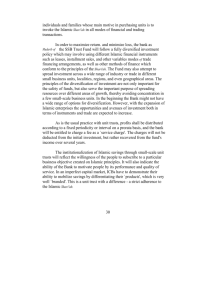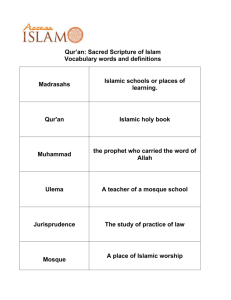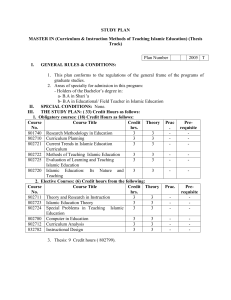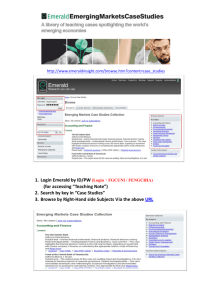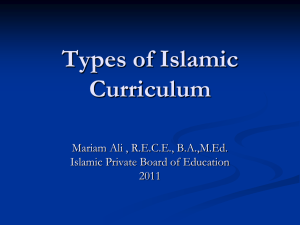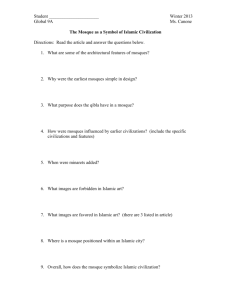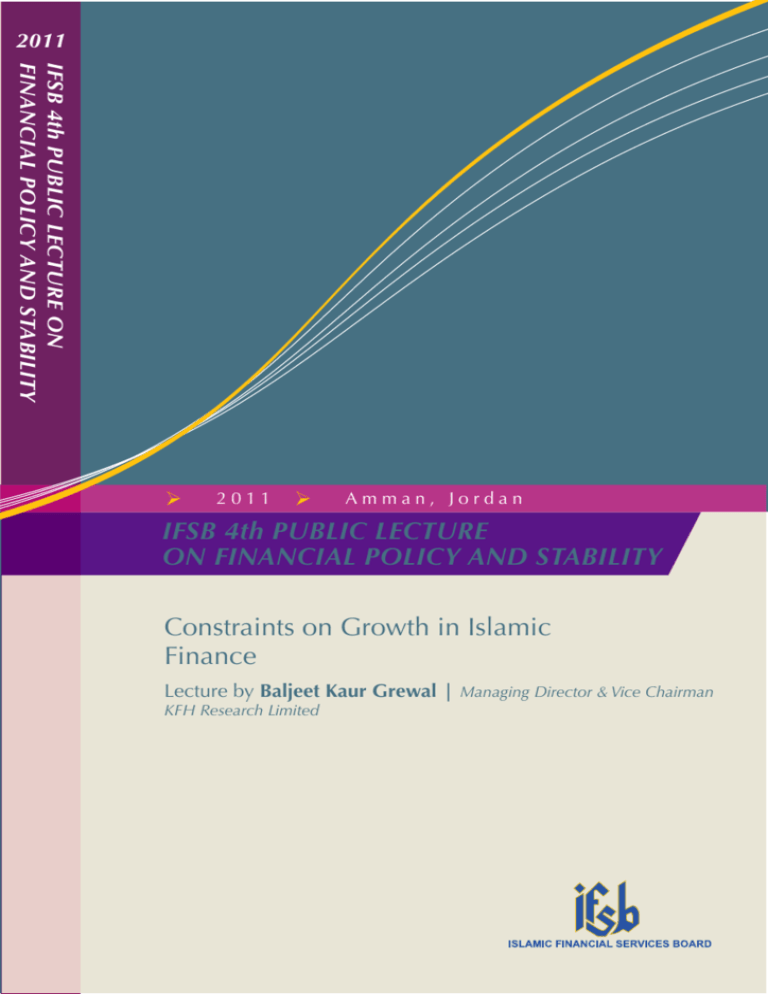
2011
IFSB 4th PUBLIC LECTURE ON
FINANCIAL POLICY AND STABILITY
2011
Amman, Jordan
IFSB 4th PUBLIC LECTURE
ON FINANCIAL POLICY AND STABILITY
Constraints on Growth in Islamic
Finance
Lecture by Baljeet Kaur Grewal | Managing Director & Vice Chairman
KFH Research Limited
The views expressed in this publication are those of the
author(s) and not necessarily the views of the Islamic
Financial Services Board.
The publication is available for download from
the IFSB website (www.ifsb.org)
Islamic Financial Services Board 2011. All rights reserved.
Brief excerpts may be reproduced or translated provided
source is cited.
Contact information:
Islamic Financial Services Board
Level 5, Sasana Kijang
Bank Negara Malaysia
50480 Kuala Lumpur, Malaysia
Tel
: + 6 03 9195 1400
Fax
: + 6 03 9195 1405
Email
: ifsb_sec@ifsb.org
ISBN: 978-967-5687-16-7
ABOUT THE ISLAMIC
SERVICES BOARD (IFSB)
FINANCIAL
The IFSB is an international standard-setting
organisation which was officially inaugurated on
3 November 2002 and started operations on 10
March 2003. The organisation promotes and
enhances the soundness and stability of the
Islamic financial services industry by issuing
global prudential standards and guiding
principles for the industry, broadly defined to
include banking, capital markets and insurance
sectors. The standards prepared by the IFSB
follow a lengthy due process as outlined in its
Guidelines and Procedures for the Preparation of
Standards/Guidelines, which includes the
issuance of exposure drafts and the holding of
workshops and, where necessary, public
hearings. The IFSB also conducts research and
coordinates initiatives on industry-related issues,
as well as organises roundtables, seminars and
conferences for regulators and industry
stakeholders. Towards this end, the IFSB works
closely with relevant international, regional and
national organisations, research/educational
institutions and market players.
For more information about the IFSB, please visit
www.ifsb.org.
Constraints on Growth in Islamic Finance
Baljeet Kaur Grewal
Islamic finance industry overview
The onset of Islamic finance as an alternative to the
conventional financial system has gained traction in the
last decade, owing to rapid financial liberalisation,
enhanced market intermediation and a growing
awareness of Sharī`ah banking. The Islamic financial
industry is today no longer a peripheral industry, but an
important component of the global financial architecture.
Total Islamic assets worldwide have increased from
approximately US$150 billion in the 1990s to in excess
of US$1 trillion in 2010, underpinned by the industry’s
strong
financial
infrastructure
and
institutional
framework, robust participation from both Islamic and
non-Islamic institutions, and a supporting regulatory
charter.
The success and development of the Islamic finance
industry is witnessed in various segments of the industry
– namely, Sukūk Islamic banking, Takāful and fund
management. As at end-2010, the Sukūk market was
estimated to be worth approximately US$143 billion. The
Islamic banking sector worldwide is valued at
approximately US$850 billion in terms of assets, while
the total global Takāful contributions have risen to
USD9.1 billion. In the Islamic funds industry, assets
under management grew by 15% globally to reach
US$52.3 billion in 2009. As at end-2010, Islamic banking
assets represented 83.4% of overall Islamic assets,
1
followed by
(4.6%).
funds (11.3%) and Islamic funds
Figure 1: Breakdown of Islamic Assets
2003
Islamic mutual funds
3.5%
Islamic equity funds
Tak ful
2.5%
0.1%
Suk k
7.0%
Islamic funds
4.6%
2010
Tak ful
0.8%
Suk k
11.3%
Islamic banking
86.9%
Islamic banking
83.4%
Sources: Central banks, IFSB, Zawya, KFHR
Extensive interest in Islamic finance from different parts
of the world is also driving the international dimension of
Islamic finance. The IFSB expects the value of global
Islamic finance assets to reach US$1.6 trillion by 2012.
2
Figure 2: A Global Industry
Sources: Central banks, IFSB, KFHR
Islamic finance has demonstrated its competitiveness
and resilience during the global financial crisis. The
industry is now entering a fundamentally different
environment in this post-crisis era. Efforts are being
focused on the further development of Islamic financial
markets, the financial infrastructure, and research and
development to support innovation, and on enhancing
the legal, regulatory and supervisory framework. These
areas are crucial in strengthening the resilience of
Islamic finance, which would in turn enhance its potential
to contribute to global financial stability and a greater
shared economic prosperity.
Today, Islamic finance is in transition to the next stage of
development: greater international integration. Hence,
collective efforts undertaken by both the regulators and
3
Islamic finance institutions to mobilise a higher level of
global cooperation will help to further propel the
prospects of Islamic finance moving forward.
As Islamic finance has become a crucial component of
the global financial system, several countries are now in
the race to become Islamic financial hubs, including
established financial centres such as London, Hong
Kong and Singapore. Encouraged by the growth of
Islamic finance centres across the globe, new markets
such as Luxembourg, South Korea and Australia also
aspire to become Islamic financial centres.
The global financial system
Global wealth currently held by 4.4 billion people has
increased 72% since 2000 to reach US$195 trillion
driven by robust growth in emerging markets, many of
which are comprised of large, diverse Muslim
populations. Global wealth is estimated to grow 61% to
US$315 trillion by 2015.
A decade ago, emerging markets accounted for 37% of
the global economy; today, they account for 46%.
According to the International Monetary Fund, emerging
markets’ share could rise to 51% by 2014 given the
continued investment. The emerging markets already
attract almost 50% of foreign direct investment (FDI)
global inflows and account for 25% of FDI outflows. Also
fuelling this robust growth are rallying commodity prices,
which are a key factor in the growing wealth of emerging
markets.
4
Figure 3: Percentage of World Net Worth (2010)
Other
2.6%
Asia
25.7%
North America
34.5%
Middle East
3.1%
Africa
0.5%
Europe
29.3%
Central/South
America
4.4%
Sources: IMF, KFHR
On the other hand, US banking assets are valued at
approximately US$13.3 trillion at the end of 2010, while
global banking assets are forecast to reach US$85
trillion by the end of 2011. To put this into context, the
value of global Islamic assets across all asset classes
remains minuscule in comparison to that of their
conventional counterparts.
5
Figure 4: Global Assets (2010)
Bank Assets
Stock Market Capitalisation
World GDP
Private Debt Securities
Pension Funds
Mutual Funds
Public Debt Securities
Insurance Companies
Reserves ex Gold
Sovereign Wealth Funds
Hedge Funds
Private Equity Funds
Islamic Finance
Total Islamic
financial assets
make up less than
1% of the total
global financial
0
20
40
60
80
USD tln
Sources: Various sources, KFHR estimates
Facing the challenge
Currently, market capitalisation of Islamic banks pales in
comparison to that of their conventional counterparts.
The top ten Islamic banks’ market capitalisation was only
4.1% of the top ten conventional banks’ market
capitalisation at end-2010.
6
100
Figure 5: Market Capitalisation (Islamic Banks vs.
Conventional Banks)
Sources: Individual ins tu ons, KFHR
Note: figures taken are latest available which range between 2009
and 2010
Concurrently, Islamic banks were much less affected by
the global financial crisis, being still able to earn a profit
while conventional banks made record losses,
exacerbating the crisis. In 2008, the net profit of Islamic
banks totalled US$4.74 billion, compared to a loss of
US$4.2 billion incurred by the conventional banks. As a
result, total assets of the top ten Islamic banks as a
percentage of the top ten conventional banks increased
from 0.8% in 2008 to 1.0% in 2010.
In the post-crisis arena, Islamic banks are facing an
uphill challenge as the conventional banks recapitalise
7
and consolidate to become bigger than ever. With large
bailouts by governments around the world and bigger
balance sheets to take advantage of devalued stocks,
conventional banks have been able to return to profit in
no time. In 2010 alone, the average top ten conventional
banks’ (by pre-crisis market capitalisation) net profit
increased by 139% year-on-year. Meanwhile, the same
statistic for the Islamic banks was a 55% decline in net
profit during the same period, due to the delayed effects
of the financial crisis and a weaker asset quality.
The largest US banks have grown larger since the
financial crisis, and the number of “too-big-to-fail” banks
will increase by 40% over the next 15 years, according to
data compiled by Bloomberg. The following US financial
institutions were swallowed up after the financial crisis,
making the big banks even bigger:
Figure 6: Institutional Consolidation
Post-Financial Crisis
Market Cap:
US$142 billion
Market Cap: US$181
billion
Market
Cap:
Market
Cap: US$5
Market
Cap: US$18
Sources: Bloomberg, KFHR
8
Market
Cap: US$5
billion
Market Cap: US$163
billion
Market
Cap: US$75
billion
The five largest institutions now make up 58% of the
total US banking assets. Islamic financial institutions will
continue to be diminutive compared to the large
conventional financial institutions and their value
proposition will remain diluted.
Reaching critical mass
The need for Islamic finance to reach critical mass
cannot be understated. It has been identified as the
number one target by industry experts for Islamic finance
to become truly competitive with the conventional
system. Ways to achieve this target could include
reaching out to untapped markets and audiences, or
consolidating existing platforms to build an entity that
can influence multiple areas of the market with expertise
and capital.
There is a need for a large-scale Islamic financial
institution, with substantial leverage in the form of vast
capital, to generate change. The current fragmentation in
the domestic markets has led to margin erosion and
difficulty in scaling up business operations. However, a
large Islamic financial institution would be able to
differentiate itself by scaling up through its presence in
key financial markets which, in turn, would give access
to vital funding sources, generate the product profile
crucial to penetrating new markets, and influence global
markets/investor awareness.
The huge infrastructure requirements in the GCC and
Asia-Pacific regions bode well for the large financial
institution as an opportunity to provide capital to meet
the growing demand for structured products and project
9
financing. Furthermore, the underserved small and
medium-size enterprise (SME) market presents huge
potential for willing partners. With abundant expertise, a
large institution may well be able to develop alternative
forms of financing, such as private equity and venture
capital, to penetrate this largely untapped market.
Another often-mentioned challenge in the Islamic finance
industry is the issue of liquidity. It is no secret that
Islamic financial markets currently lack the liquidity,
breadth and depth of conventional financial markets.
Islamic financial institutions’ (IFI) product range has
developed rapidly over the last ten years to meet the
demand from both retail and corporate entities. However,
IFIs still face the challenge of a lack of instruments to
manage liquidity. As a result, products are short-ended
given the current constraints. Therefore, it is critical for
Islamic financial institutions to innovate and revolutionise
Sharī`ah-compliant products to enhance and manage
liquidity. Large Islamic financial institutions can enhance
market liquidity, and hence product pricing, by
integrating their global and regional market operations.
10
Figure 7: Product Development and Liquidity
Conundrum
Lack of
liquidity
management
tools
Sukūk
Asset &
Wealth
Management
Equities
Syndications
& Club Deals
Tradability
of liquidity
instruments
remains an
issue
Structured
Finance
Current Islamic Products
& Services
No lender of
last resort in
times of
liquidity
needs due to
interest
therein
Source: KFHR
Many banks may still have limited capabilities and
expertise to consistently originate and structure large
Islamic deals, which can often comprise pioneering
arrangements and features. The need for highly skilled
staff therefore increases with the development of
innovative Islamic financial products and services. To
meet this human capital requirement, large financial
institutions can act as knowledge centres to attract
foreign talent from the existing international financial
hubs, as well as retain local talent.
11
Further areas of focus in capacity building and talent
development include:
• the need for practitioners and stakeholders to
be highly qualified and equipped with the
requisite technical knowledge and skills;
• the need for specialised training and
educational institutions;
• the development and adoption of industry best
practices, as well as the harmonisation of
Sharī`ah practices while reviewing standards to
facilitate
policy
development
and
implementation;
• the collaboration and exchange of knowledge
across jurisdictions; and
• supplementary research into and development
of key specialised areas.
The second area for reaching critical mass is Islamic
microfinance. In 1963, an Islamic version of the
microfinance model was developed in Egypt. Currently,
there are more than 200 Islamic microfinance institutions
around the world.
The supply of Islamic microfinance is currently
concentrated in a few countries, mainly Indonesia,
Bangladesh and Afghanistan, which account for around
80% of global outreach. Despite the strong growth of
Islamic finance over the years, Islamic microfinance is
still in its nascent stage and currently forms part of an
informal economy.
A 2007 global survey on Islamic microfinance
undertaken by the Consultative Group to Assist the Poor
12
shows that Islamic microfinance has an estimated global
outreach of only 380,000 customers and accounts for
only around 0.005% of total microfinance outreach.
Although 2010 estimates now put this figure at 0.05%,
the potential still remains mainly untouched.
Figure 8: Selected Countries’ Microfinance: Gross
Loan Portfolio (2010E)
China
Malaysia
Jordan
Sri Lanka
Pakistan
Egypt
India
Afghan
Bangla
Indo
0
5,000
10,000
15,000
USD million
20,000
25,000
Sources: Mixmarket, KFHR
The SME market is a largely untapped space with huge
potential, especially in emerging markets where
economic growth is robust. Islamic microfinance is
designed to work together in this space, which could
catapult Islamic finance to the market penetration it
needs for the masses.
The slow growth in Islamic microfinance is due mainly to
the fact that such facilities were usually provided by
specialised institutions such as non-government
13
organisations, and not by Islamic banks, despite the
many elements of microfinance which can be considered
consistent with the broader objectives of Islamic banking.
For the industry to reach its full potential, Islamic
microfinance should be integrated into a country’s
mainstream banking and financial system. This will help
to:
• create greater awareness of products;
• encourage product innovation;
• improve access to microfinance;
• widen and strengthen the distribution channels;
and
• standardise
regulation
and
improve
transparency.
The regulatory challenge
A big part of the recent financial crisis can be blamed on
regulatory failures. As a result of the financial crisis, the
global financial sector lost almost US$1.8 trillion, which
sent many economies into a recession. Financial
markets had been subject to gross liberalisation over the
last ten years, which allowed financial institutions to dish
out credit to uncreditworthy customers and create the
highly complex financial derivatives to bet against,
without having to answer for the consequences thereof.
The lack of regulation during the global recession has
led many economists to reconsider their views on the
market-based model of economic theory and its viability
in today’s societies in conventional banking. Many
governments around the world have introduced financial
and economic reforms as a form of government
intervention to produce a well-regulated financial
14
environment with the aim of preventing a similar financial
crisis in the future.
Figure 9: Worldwide Write-Offs and Credit Losses
35
81
45
1,774
10:Q1
Total
147
Q4
1,325
1,200
800
400
Q2
09:Q1
0
2007-2008
USD bln
1,600
141
Q3
2,000
Sources: The World Islamic Banking Competitiveness
Report 2010–2011, KFHR
Bold measures are being developed in various
international forums with fundamental changes to the
current approaches to financial regulatory and
supervisory oversight. The new regulatory framework is
aimed at being one that is premised on a greater
emphasis on ethics, fairness and accountability, and
which promotes global economic, social and
environmental sustainability. It should be anchored on a
sensible balance of supporting growth while maintaining
financial stability, and be founded on greater
international coordination of regulatory approaches and
supervisory oversight with a crisis management
framework that will reduce systemic risk and the severity
of any such future financial crises.
15
Islamic finance, which is fast becoming a unique and
integral part of the global financial system, will inevitably
be impacted by the changing global landscape of
financial
regulation,
especially
given
the
internationalisation and continued growth of Islamic
finance. The global call for improved regulation and
increased oversight will thus intensify the efforts that
have already been undertaken to strengthen the
financial regulation of Islamic finance.
To support the orderly development of Islamic finance, it
is vital to accelerate the development of the critical
building blocks of the Islamic financial system in order to
respond to the changing economic and financial
landscape. This is important to ensure a more integrated
Islamic financial services industry globally that is able to
withstand shocks and adverse market developments
through putting in place building blocks that will
strengthen the resilience of the Islamic financial system
and by the application of mutually acceptable rules and
standards.
With this in mind, the building blocks of a robust and
sound regulatory framework are at the core of Islamic
finance. Starting at the top, any Islamic organisation
must ensure proper corporate governance processes
which are relevant and particular to Islamic principles.
Combined with proper oversight at both the board and
senior management levels, this will ensure that a large
financial institution will not be the cause of a systemic
failure of the kind witnessed in the global financial crisis.
16
At a risk management level, it is central that institutions
must incorporate risk sharing between the organisation
and its clients and customer base. The risk-sharing
principle is at the heart of Islamic economics and has led
experts such as Abbas Mirakhor to conclude that sharing
risk is central to insulating an economy from shocks
similar to those of the financial crisis. The growing
dependency on debt-based instruments was a major
contributor to the viscosity of the global financial crisis.
Therefore, the introduction of liquid, equity-based risksharing instruments will shield institutions from the
effects of future shocks and help to build a more
sustainable financial system.
Equally important is a prudent capital adequacy
framework. In 2005, the IFSB introduced its second
standard, which covers the capital adequacy of
institutions offering Islamic financial services. The
standard is important to reference, as it is the first in the
world to recognise the inherent risks of Sharī`ah
contracts and deals with them by assigning risk weights
thereto, thereby creating a level playing field among the
Islamic institutions in adopting and developing risk
identification and measurement practices that meet
internationally acceptable prudential standards. A unified
adoption of this standard will ensure that institutions
offering Islamic financial products and services assign
sufficient capital to cover the risk of the institution’s
Islamic operations. The IFSB standard is currently the
only international guideline to integrate the Islamic
contracting principles.
17
Case study: Malaysia
It is largely viewed that Malaysia was resilient against
the global financial crisis due to the country’s strong
fundamentals and inherently sound financial regulatory
framework. Furthermore, the domestic banks were not
directly exposed to the US sub-prime crisis, thanks to the
government’s earlier rules that limited the outflow of
foreign investments.
Figure 10: Performance of the Equity Markets in 2008 and 2009
Index
Malaysia
South Korea
Taiwan
Thailand
Hong Kong
China
Singapore
Indonesia
India
2008 Returns
–39.30%
–40.70%
–46.00%
–47.60%
–48.30%
–48.90%
–49.20%
–50.60%
–52.90%
2009 YTD Returns
–2.10%
–6.20%
1.40%
–6.80%
–17.10%
–12.10%
–14.10%
–5.10%
–13.70%
Sources: Bloomberg, KFHR
Note: Year-to-date as at 6 March 2009
Similarly, Islamic banking in the country was well
shielded from the effects of the crisis due to the Islamic
financial institutions’ strict adherence to Islamic
principles, which prevents high levels of leveraging and
speculative activities. The majority of Islamic banks’
capital remained strong despite an economic slowdown
in the country.
Malaysia is one of the pioneering countries in
successfully developing its Islamic finance industry. The
18
government and regulators are highly committed to
developing a complete Islamic financial system that
includes banking, Takāful and the capital market. Since
the start of Islamic finance in the country in 1969 with the
establishment of the Pilgrim Fund, Islamic finance has
grown tremendously to become a truly integral part of
the financial system, operating side-by-side with the
conventional system. This systematic development has
required a huge effort on the part of the regulatory
bodies in order to produce a favourable environment for
this rapid growth to take shape.
Figure 11: Milestones of Malaysia’s Islamic
Finance Industry
Sources: GIFF Report 2010, KFHR
As Malaysia moves forward with its economic
transformation programme, the demands placed on the
financial sector to be an enabler, catalyst and driver of
growth will increase. The financial sector as a whole is
expected to grow in size, from 4.6 times GDP now to 5–6
19
times GDP by 2020. The significance of financial
markets, relative to funds raised through financial
intermediaries such as banks, will continue to rise. In
meeting the needs of the new high-value-added
economy, the financial sector needs to be developed
further and become innovative in its approach in order to
facilitate higher levels of domestic and international trade
and investment. One such innovative approach is the
development of a comprehensive and vibrant Islamic
financial industry.
To match this rapid growth, the regulatory authorities
have introduced a comprehensive regulatory and
supervisory framework for Malaysia’s dual financial
system. Stronger standards have been set for corporate
governance, transparency, disclosure, accountability,
market discipline, risk management and customer
protection. These various measures put in place by the
authorities have enabled Malaysia to be ranked the tenth
most competitive nation in the World Economic Report
by IMD, Switzerland. Some of the domestic regulations
introduced include:
• Corporate Governance Guidelines;
• Rate of Return Framework;
• Guidelines on Financial Disclosure;
• Sharī`ah Committee Guidelines;
• Islamic Money Market Guidelines;
• Capital Adequacy Standards;
• Mushārakah and Muḍārabah;
• PSIA Risk Absorbent Framework;
• Property
Development
and
Investment
Activities; and
• Firewalls for Islamic Window Operations.
20
To instil financial stability, market discipline and public
confidence, the above regulations are married with the
following international best practices and guidelines:
• Capital Adequacy Standard (2005);
• Guiding Principles on Risk Management (2005);
• Guiding Principles on Corporate Governance
(2006);
• Transparency and Market Discipline (2007);
• Supervisory Review Process (2007);
• Capital Adequacy for Sukūk, Securitisation &
Real Estate Investment (2009); and
• Guiding Principles on Governance for Islamic
Collective Investment Schemes (2009).
A strong Sharī`ah framework helps to increase
consumer confidence and provides greater flexibility for
Islamic financial institutions to be innovative within the
boundaries of the Sharī`ah. To this effect, Bank Negara
Malaysia (BNM) introduced its Sharī`ah Governance
Framework (SGF).
The SGF outlines the expectations of BNM on Islamic
financial institutions’ Sharī`ah governance structures,
processes and arrangements to ensure that all their
operations and business activities are in accordance with
the Sharī`ah. Given the rapid developments in Islamic
finance over recent years, the SGF aims to strengthen
the Sharī`ah governance process, decision-making,
accountability and independence of Sharī`ah advisories.
In this regard, the new SGF will provide comprehensive
guidance on the roles and responsibilities of the
Sharī`ah committee, the board and the management of
21
Islamic financial institutions to ensure that
operations are in compliance with the Sharī`ah.
their
This extraordinary step by the Malaysian central bank is
the first attempt in the world at providing a
comprehensive framework to regulate all facets of
operations of the Islamic financial institutions in
accordance with the Sharī`ah.
This extraordinary step by the Malaysian central bank is
the first attempt in the world at providing a
comprehensive framework to regulate all facets of
operations of the Islamic financial institutions in
accordance with the Sharī`ah.
Another initiative by the country’s regulatory authorities
was to set up an international Islamic financial centre
that would help to promote a better understanding of
international Islamic finance, as well as take initiatives to
make Malaysia a better-regulated and more attractive
destination for Islamic finance.
The Malaysia International Islamic Financial Centre
(MIFC) initiative launched in 2006 helped to strengthen
the country’s position as an international hub of Islamic
finance. The MIFC initiative comprises a community
network of financial and market regulatory bodies,
government
ministries
and
agencies,
financial
institutions, human capital development institutions and
professional services companies that are participating in
the field of Islamic finance.
22
Under the MIFC initiative, financial institutions are
welcomed to use Malaysia as a platform for their Islamic
finance activities, leveraging on the comprehensive
system and conducive environment for Islamic finance
business available in Malaysia. Various incentives are
accessible to financial institutions participating in MIFC,
including new licences for conducting foreign currency
businesses, attractive tax incentives and facilitative
immigration policies.
Overall, these initiatives and regulations have the
following effects on the Malaysian Islamic financial
system:
• maintain the confidence of the public with IFIs
as the custodians of public funds;
• promote a competitive financial system which
provides efficient and reliable services;
• ensure the health of each IFI for the
development of a sound and stable financial
system;
• prevent the risk of a contagion and systemic
failure of the financial system;
• promote good market practices and high
standards of corporate governance;
• ensure IFIs are managed competently by strong
and capable management teams; and
• protect customers’ and stakeholders’ interests.
23
Conclusion
It is critical to build the robust components of the
financial infrastructure and to strengthen key institutions
to ensure the stability and dynamism of the Islamic
financial system. In this regard, the IFSB highlights the
eight building blocks required for strengthening the
Islamic
financial
infrastructure.
Together,
they
incorporate strong governance, which is crucial to the
Islamic finance industry moving ahead. Nevertheless,
the leverage of Islamic finance and its sustainability can
only be further enhanced by a large, sizeable Islamic
financial institution that is able to compete in the global
arena against the current large conventional banks.
For Islamic finance to reach the next wave of growth, it
must extend to reach the critical mass. Opportunities to
get there include the following:
• A large-scale institution, which will have all
the capabilities to penetrate the various
segmented markets with expertise and
knowledge while providing Sharī`ah-compliant
financial solutions.
• Microfinance, which has the potential to create
opportunities for the untapped SME market of
the emerging economies and to capture interest
in Islamic microfinance needs.
• Sound regulation to ensure that Islamic
finance has a decent chance of growth and
development while expanding to the critical
mass.
Some of the remaining challenges to be overcome
include the development of human capital, enhancement
24
of product development, identifying the right
opportunities, and the delivery of appropriate returns for
the risks involved.
The emerging markets are witnessing robust economic
growth, with the SME market remaining an unexploited
sector in these territories. This large potential, which is
also supported by the growing Muslim population, could
propel Islamic finance to the next level.
25
Baljeet Kaur Grewal is Managing Director &
Vice Chairman of Kuwait Finance House
Research Ltd. Kuwait Finance House is also the
only Islamic bank worldwide with a notable
Investment Banking Research presence,
instrumental in promoting Islamic banking and
facilitating portfolio fund movement globally.
Prior to this, Baljeet was attached to Maybank
Group Malaysia, ABN AMRO Bank and
Deutsche Bank, London, with her experience
ranging from credit structuring, origination and
syndication to capital market research. She has
broad experience in investment banking, having participated in notable
fund-raising transactions in Asia and the Middle East.
To date, she has undertaken research in Islamic finance with a principal
focus on debt capital markets and sukuks. She has written and published
numerous articles on developing economies and debt markets, world
economic growth, and the GCC and South-East Asian economies, and has
addressed numerous international conferences and forums.
Baljeet holds a first-class honours degree in International Economics from
the University of Hertfordshire, UK and has undertaken extensive research
with the London School of Economics and international bodies. She is
currently pursuing her Executive MBA at Cambridge University, UK. She is
also the recipient of the prestigious Sheikh Rashid al-Maktoum Award for
Regional Contribution to Islamic Finance in Asia 2006.
Under Baljeet’s leadership, KFH Research has recently won the following
awards:
Best Research in Islamic Finance, Master of Islamic Funds Awards,
Islamic Fund World 2007
• New Provider for Islamic Finance Research, KLIFF 2008 Islamic Finance
Awards
• Best Islamic Research Company, Islamic Finance News Awards Poll 2008
• Contribution to Research in Islamic Finance 2008, International Islamic
Forum Dubai
• Best Islamic Finance Research House, The Asset Triple A awards 2009
Islamic Finance
• Best Islamic Finance Research House, The Asset Triple A awards
2010
•
ISBN 978-967-5687-16-7

